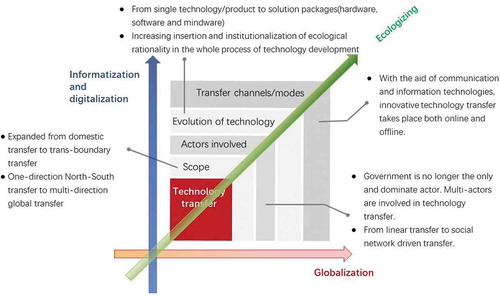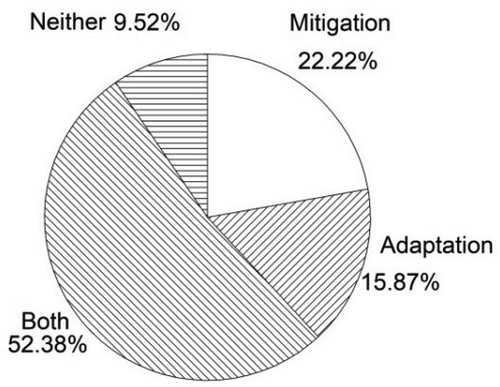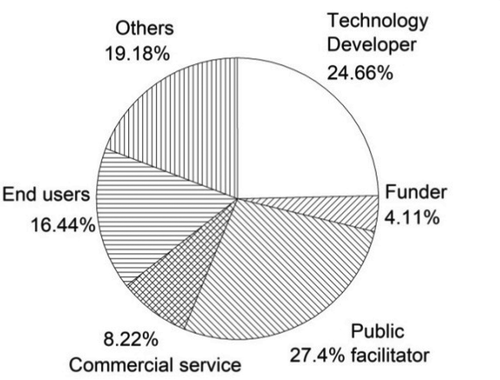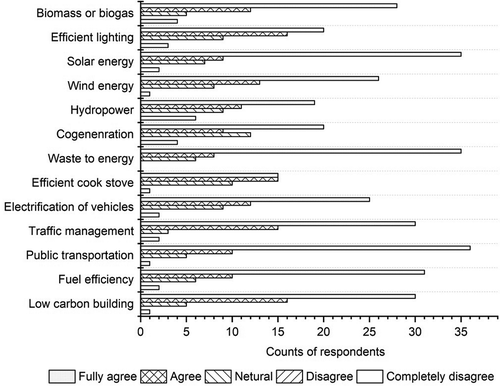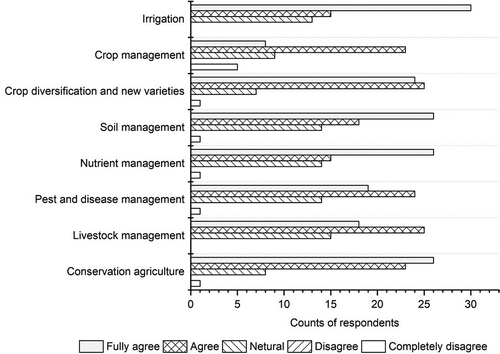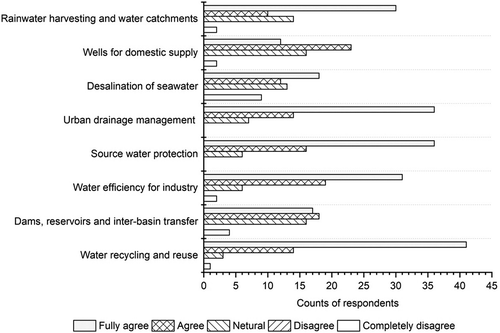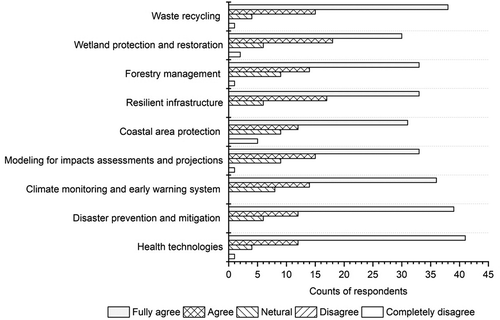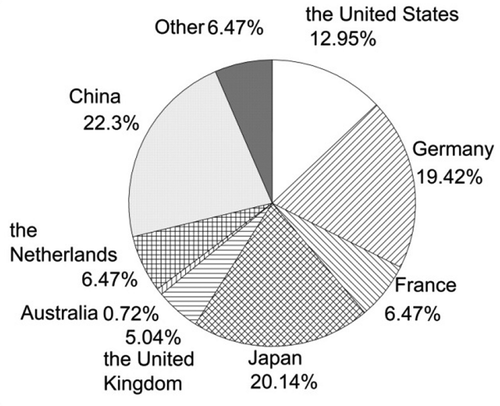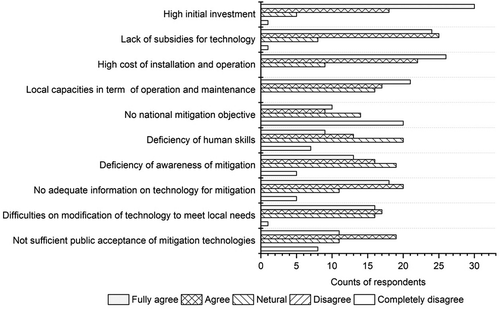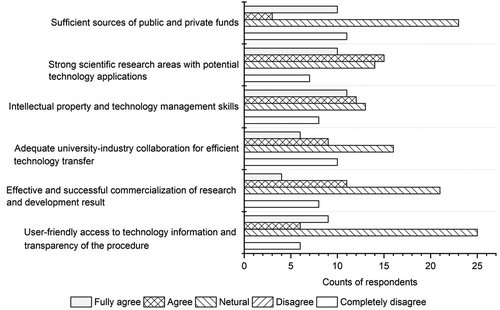ABSTRACT
Technology is an instrument to build BRI relationships, mitigate the environmental and climate impacts of BRI projects, as well as to enhance environmental sustainability in the regions. This study aims to reposition China in global climate technology transfer in BRI era and to obtain initial knowledge on needs, priorities, and barriers from the receivers’ perspective. Focus group method with aid of questionnaire survey and follow-up face-to-face interviews was adopted to capture the major issues directly expressed by receivers from these countries. A total of 63 valid questionnaires were collected, and 13 respondents were face-to-face interviewed. The results confirmed that energy and agriculture were the most prioritized sectors for mitigation and adaptation in the developing countries alongside OBOR. The prioritized technologies for mitigation included cogeneration, solar photovoltaic, and biomass/biogas electricity. Irrigation, conservation agriculture, and soil management were prioritized for adaptation in agricultural sector, and water recycling and reuse, source water protection, and urban drainage management in water resource sector. Technology cost during installation and operation was stressed as the most important factor constraining the application and diffusion of climate technologies. But communication including language, information, and ways of communication, was also identified as an important factor. This implied that the conventional climate technology transfer need adapt to changing contexts of BRI and be complemented with innovative approaches involving multi-actors in different phases of climate technology development. Due to the limited representativeness of the sample, the results can hardly be generalized to all the countries, but raised interesting topics for future researches.
Introduction
The Belt and Road Initiative (BRI) is a transcontinental, long-term, all-dimensional, and multi-tiered program which combines two initiatives, i.e., the Silk Road Economic Belt and the 21st Century Maritime Silk Road. BRI was initiated in the fall of 2013 by Chinese president Xi Jinping and was known as One Belt One Road (OBOR). As a global initiative, BRI aims to accelerate the infrastructural connectivity and economic integration of countries along and beyond the route of the historic Silk Road, and bring Asia, Eastern Africa, Eastern Europe, and the Middle East closer together to promote trade, more efficient resource reallocation, and economic growth across regions. Despite all the controversies, justified or unjustified criticism, BRI has been growing since 2013, in terms of number of participating parties and cooperation projects, scale of infrastructure construction, size of trade and financial flows, and physical and cultural connectedness.
Serious concerns have been raised that, by promoting infrastructure investment, BRI could lock host countries into fossil fuel dependency for the coming decades and hamper them from reaching their national determined contribution targets as established under the Paris Agreement (Losos et al. Citation2019). In the meanwhile, developing countries along the Belt and Road are very vulnerable to the negative impacts of climate change, particularly various climatic extremes and disasters, due to the poor infrastructure and fragile environment (Zhang et al. Citation2019). Technology, knowledge combined with appropriate means to transform materials, carriers of energy or other types of information from less desirable to more desirable forms, is a significant instrument to build BRI relationships as well as to enhance resilience to climate change and environmental sustainability in the region. However, past international experiences showed that effective technology transfer is subject to a number of conditions and factors that are often out of full control of any single actor involved in the process.
Climate technology refers to technological means to mitigate greenhouse gas (GHG) emissions, adapt to adverse effects of climate change, and help improve resilience. In this study, technology is defined in its broadest sense to include methods, systems, devices, and know-hows, which are used for any kind of individual or societal purpose. By adding “climate” in front of “technology,” we refer to all the means and ideas that help both with mitigation of sources or removal of sinks to stabilize the greenhouse gases concentration in the atmosphere, and with adaptation to the changing climate, being from product design to system and regime changes. Given the uniqueness of climate problems, the invention, innovation, diffusion, transfer, and adoption of technologies need be strategically facilitated and managed. However, although described as “hopeful monstrosities” (Mokyr Citation1990, 291), new technologies cannot immediately compete on the market against established technologies. This problem is pivotal for many new technologies with sustainability promise (Schot, Hoogma, and Elzen Citation1994; Schot and Geels Citation2008), as many new technologies failed the “valley of death” on their journey to market introduction or wide adoption by users (Schot and Geels Citation2008).
Developing and transferring technologies to support national action on climate change has been an essential element from the beginning of the negotiation process for United Nations Framework Convention on Climate Change (UNFCCC). International cooperation to facilitate the development, transfer, and uptake of climate technologies in developing countries is an ongoing part of climate policy conversations. Previous studies under UNFCCC TEC have identified various barriers facing climate technology transfer, ranging from lack of finance and motivation on both supply and demand sides, legal and regulatory issues, different ranking of priorities, fragmentation of information and institution, limited human skill and capacity, intellectual property rights, lack of awareness, and different cultural backgrounds and lack of leadership in trans-boundary governance, etc. (UNEP DTU and UNFCCC, Citation2018; Ockwell, Sagar, and de Coninck Citation2015). Limiting global warming to 2.0/1.5°C and adapting to an increasing global temperature will require rapid and deep alteration of attitudes, norms, incentives, politics, and international affairs. Some of the most burning unsolved climate-change and transition puzzles are therefore in the realm of the social sciences. However, these are precisely the fields that receive least funding for climate-related research around the world. Putting new wine in old bottles won’t work (Mowery, Nelson, and Martin Citation2010).
BRI may create new market demands for climate technologies and provide new opportunities, mechanisms, and channels for technology transfer; still, wide adoption of climate technologies by users in BRI countries must overcome a range of barriers. The role of China is changing from mere receiver of climate technology transfer from the North to supplier to the South, simultaneously. Co-learning with involved parties toward solutions will be crucial for the needed climate technology transfer. It is desirable that China has trumpeted its commitment to build a green and low-carbon BRI, yet the realization of this “green soft power” remains a challenge to all the countries involved. This study aims to reposition China in global climate technology transfer in BRI era and to obtain initial knowledge on needs, priorities, and barriers from the receivers’ perspective.
Research framework, method and data collection
As defined by the Intergovernmental Panel on Climate Change (IPCC), technology transfer is “ … a broad set of processes covering the flows of know-how, experience and equipment for mitigating and adapting to climate change amongst different stakeholders such as governments, private sector entities, financial institutions, non-governmental organizations (NGOs) and research/education institutions … ” (GEF, Citation2019). Over the past decades, technology transfer has been changing fast in terms of connotation of technology itself, actors/factors involved, channels, and modes of transfer. illustrates how the globalization course, informatization, and digitalization, and pursuit for more sustainable future have changed the various aspects of technology transfer. Technologies as solution packages to specific local problems are increasingly shaped with green standards and demands from governmental and non-governmental actors. How technologies are transferred has been innovative: with the aid of communication and information technologies, innovative technology transfer channels and modes that use different mechanisms are emerging both online and offline. Trans-boundary technology transfer used to be mainly initiated and organized by governmental organizations or companies. Now it is important to recognize roles of NGOs, consultancy services, bridging organizations, research institutes, process integrators, and consumer groups, etc. Through literature review and study on reported cases, categorizes technology transfer modes based on the types of initiators and the main functioning mechanism used.
Table 1. Technology transfer modes based on initiators and mechanisms.
This review provides the base for our research design that aims to identify climate technology needs, ranking of priorities, preferred technology transfer modes, and barriers from perspectives of receivers of BRI countries.
Given the diversity and large number of BRI countries, it is challenging to conduct direct on-site investigations guided with the same research design. In order to capture the major issues directly expressed by receivers from these countries, focus group method was adopted for this study. Taking the advantage of a series of Training Course on Low Carbon Technology and on Climate Finance in Beijing from August to September, 2019, structured questionnaire was used to collect comparative information and then face-to-face interviews followed to dig further personal feedbacks. The training was hosted by the Institute for Sustainable Development Goals of Tsinghua University (TUSDG). This training was a part of the South-South Cooperation Initiative on Climate Change, aiming to share the experiences, lessons, and practices for addressing climate change, enhance mutual understanding and support on climate change between China and other developing countries, promote cooperation in policies, standards, and practical products, and improve the capacity in addressing climate change of developing countries, through a variety of capacity building training activities.
The questionnaire covers three sections: 1) basic information of the respondent, focusing on relevance to climate experience; 2) perception of climate change challenges and technology needs (mitigation and adaptation) in respondent’s country; 3) technology transfer in the country, including barriers and opportunities for technology transfer for mitigation and adaptation. Based on a quick and primary analysis of the results, face-to-face group interviews helped further clarify some questions, particularly on the barrier and possible solutions to enhance technology transfer in BRI. In total 70 questionnaires were distributed for this research, and a total of 63 valid questionnaires were collected with 6 anonymous respondents.
After the survey, we conducted two sessions of face-to-face interviews, respectively, on 13 September 2019, and 27 September 2019. Based on respondents’ willingness, a total of 13 interviewees from 13 countries were selected for the follow-up interview with a consideration of the diversity of region, sector, and organization. All interviewees all have longer experiences in the work related to climate change, and some of them have expertise in particular mitigation and adaptation areas, such as biomass, solar, or wind energy, water management, and agriculture. Therefore, in the interviews, they shared with us their perceptions and observations on the current status of climate technology deployment in their countries and the key barriers for climate technology transfer (such as limited accessible information, high installation cost, difficulties of maintenances, poor sustainability of project-based technology transfer). Some interviewees demonstrated cases of success or failure for climate technology transfer, such as the solar technology transfer between China or Europe and Panama, and the technology development and diffusion in Indian. They also introduced the stakeholders in technology transfer process, and provided solutions to enhance the technology development and transfer in developing countries.
Results and discussions
Basic information of interviewees
Those 63 respondents are from 29 countries from Asia (8 countries), Africa (10 countries), and other regions (10 countries). Among them, only 10% have no experiences on climate change, more than 50% have experiences both on low carbon development or mitigation and adaptation. And, 22% only have experiences on mitigation and 16% have experiences on adaptation (). The 13 interviewees are from 13 countries, including 4 Asia countries, 5 Africa countries, and 4 countries in Latin America.
Regarding their specific work experiences, almost 49% of respondents are from environment sector, 24% from agriculture and forestry sector, 16% from energy sector, 4% from water sector, and 5% from urban and health sector (). Besides, there is one respondent working in the sector of disaster risk reduction, and one in the sector of marine and fishery. But no respondent has working experience in transportation. Eighteen respondents have experiences in more than one sector.
Due to the difficulty to conduct a strictly stochastic sampling, the disadvantage of focus group method is the sampling with deviation. But the results showed that the range of respondents covers key types of stakeholders involved in technology transfer; 27.4% and 24.7%, respectively, of the respondents are from organizations which play a role as public facilitator and technology developer (); 16.4% and 8.2%, respectively, are from organizations which are end-users of technologies and providers of technology-related commercial services; 4% of respondents’ organizations are funders for technology development, cooperation, and diffusion. Other stakeholders, including non-governmental organizations (NGOs) also play important role for technology development and transfer in developing countries. As most respondents have sufficient knowledge and experiences about technology transfer and development related to climate change. They showed enthusiasm for the study, and are very responsible for their answers, as most of them (more than 90%) left names and contacts for further face-to-face interview. They also showed strong willingness to be engaged with future possible technology transfers between China and their countries.
Perception of climate change challenges and technology needs
The respondents show high recognition and perception of challenges from climate change. More than half of the respondents fully agree that climate change exerts profound negative impacts on infrastructure (63.5%), water (57.6%), forest (56.7%), and domestic migration from zone affected (55.8%) (); 47.5% fully agree with the negative impacts on crop growth and yields, while another 29.5% moderately agree with this. More than 80% agree with the negative impacts of climate change on biodiversity and extinction of species. About two-thirds agree that mild winters will exacerbate the spread of pests and diseases, and that extreme events interrupt transportation. In the interviews, interviewees emphasized the threats of extreme climatic disasters, such as flood and drought, to livelihood, infrastructure, and even lives.
Across all regions, energy and agriculture are recognized as the most prioritized sector for mitigation and adaptation, respectively. This result accords well with the results of technology needs assessment (TNA) for non-annex I parties by UNFCCC (UNFCCC Citation2013), as well as with the results of some regional studies, e.g., the Asian Development Bank (Citation2014). Transport, land use change and forestry, waste management, and agriculture were also prioritized for mitigation, while water, coastal zone, land use and forestry, public health, and natural disasters for adaptation (UNFCCC Citation2013). Building upon previous TNA studies, we tried to zoom in the relatively importance of needs across different technologies. Thus, we developed a list of technology for mitigation, and three lists of technology for adaptation in agriculture sector, water sector, and other sectors. However, our results show moderate inconsistence on the prioritized technology for mitigation with UNFCCC TNA. Their results show that the majority of the technologies prioritized for mitigation were cogeneration, solar photovoltaic, and biomass/biogas electricity; followed by efficient lighting, waste to energy, wind turbines, and hydropower. As shown in , respondents in this study show highest agreements on their needs of public transportation, waste to energy, and solar energy for mitigation.
UNFCCC TNA recognized biotechnology as the top priority for adaptation, as most countries look for new varieties that are drought-resistant, flood-resistant, salient tolerant, and short-maturing in order to adapting to the warming temperature, unevenly precipitation and increasing extreme events. However, respondents showed greatest agreements on their needs of irrigation, conservation agriculture, nutrient management, and soil management for agricultural sectors (), needs of water recycling and reuse, source water protection and urban drainage management for water resource sector (), and needs of health technologies, disaster prevention and mitigation, and waste recycling for other sectors ().
This confirmed the rationale of the ranking in UNFCCC TNA. But we did observe the disagreements on some technologies. For example, highest divergence is shown for hydropower and efficient cook stove for mitigation, while for dams (reservoirs, and inter-basin transfer), desalination of seawater, and wells for domestic supply for adaptation. After the face-to-face interview with 13 interviewees, we assumed the disagreement is due to the difference in the development stage and resource empowerment of the country as well as in the preference and value judge of the respondents. For example, an interviewee believed that adaptation technologies play more important role than mitigation role in Laos, due to the ever-increasing serious impacts of climate change. However, as so far the samples cannot support empirical analysis, but we consider identifying the influence factors for the difference in further research.
Barriers and opportunities for technology transfer in OBOR
Generally, in countries alongside OBOR, China, Japan, and Germany are the perceived top providers for climate change technologies, as 22%, 20%, and 19% of total respondents think where their climate technologies were from. The United States, France, and the Netherlands and the United Kingdom also play key roles in meeting technology needs in countries alongside OBOR ().
Our survey data show that high initial investment is the top one important barrier for technology transfer and diffusion for mitigation in countries alongside OBOR, as 55.6% and 33.3% of the respondents, respectively, fully agree or agree with the statement (). Only one respondent disagree with this statement. The following top two important barriers are lack of subsidies for technology and high cost of installation and operation, as 84.5% and 84.2% of respondents agree or even fully agree with the two statements. Respondents also showed high agreements on local capacity in terms of operation and maintenance (70.4% agree), no adequate information (70.4% agree), difficulties on modification of technology to meet local needs (66% agree), not sufficient public acceptance (61.2% agree), and the deficiency of awareness of mitigation (54.8% agree). But respondents were fairly divided on the barrier on deficiency of human skills (44.9% agree), and no national mitigation objective (35.8% agree), which show their reluctance if they could be regarded as barriers for technology transfer on mitigation.
For adaptation, respondents also agree that lack of subsidies for technology (78.2% agree), high initial investment (74.5% agree), high cost of installation and operation (76.4% agree), and difficulties on modification on technology to meet local needs (77.4% agree) are important barriers for technology transfer and diffusion (). However, deficiency of awareness of adaptation, deficiency of infrastructure, and local capacity in terms of operation and maintenance were also identified as important barriers for adaptation, as 79.6%, 78.8%, and 75.9% of respondents agree or even fully agree with these statements. Compared with mitigation, respondents show lower agreement on the no sufficient public acceptance (66.0% agree), no adequate information on technology (67.3% agree), but higher agreement on deficiency of human skills (62.3% agree).
Respondents were divided when it came to the solution for enhancing technology development and diffusion in countries alongside OBOR. They doubted if their country could provide sufficient sources of public and private funds for technology, as more than 25% of respondents hold a neutral attitude, and 10% completely disagree (). They were also skeptical if user-friendly access to technology, effective and successful commercialization of research and development could promote the technology transfer in their countries, which indicated the low capacity of developing countries in facilitating technology development.
The factor of cost, including that of installation and operation, was stressed in the following interviews, as all interviewees identified it as the most important factor constraining the application and diffusion of both mitigation and adaptation technologies. Besides the factors listed in the survey, communication, including language barrier, insufficient information, and ineffective ways of communication, was identified by all the interviewees as a very important factor hindering technology transfer between China and other developing countries. Although climate technologies invented and commercialized by China companies were attractive to them (relatively lower cost and easier to be installed and implemented), such as biomass, solar energy, wind energy, and irrigation, they failed to access enough information. This situation is even worse for countries where English is not native language. Unlike easily accessible information from western suppliers, it is very difficult for them to get sufficient information of climate technologies in English or their working language from relevant Chinese suppliers. The official English websites of some Chinese companies usually lack of sufficient descriptions and detailed parameters of equipment and technologies, as well as trustable contact of suppliers. The interviewees wished for better information disclosures of Chinese technologies in different languages and more active, direct engagements of diverse stakeholders, particularly all kinds of private and public facilitators for the commercial service of climate technologies.
It is important to note that we were not able to conduct a rigorous random sample and the current valid sample size was relatively small, due to the cost, time, and space constraints. We may not reach those respondents that can only respond using alternate conceptions and preferences. In this study, 10% of respondents had no experiences with climate change mitigation or adaptation, they may not be fully aware of their reasons for any given answer because of lack of memory on the subject. Given the large numbers of countries alongside OBOR and diversity of national circumstances of BRI countries, the results can hardly be generalized to all the countries. But this study is a good attempt, and it should be followed up with more first-hand data collection and evidence-based researches in these regions.
Conclusions and implications
The results confirmed that energy and agriculture are the most prioritized sector for mitigation and adaptation in the developing countries alongside OBOR, respectively. In the region, the prioritized technologies for mitigation include cogeneration, solar photovoltaic, and biomass/biogas electricity. Irrigation, conservation agriculture, and soil management are prioritized for adaptation in agricultural sector, and water recycling and reuse, source water protection, and urban drainage management in water resource sector. Technology cost during installation and operation was stressed as the most important factor constraining the application and diffusion of climate technologies in the region, but other factors are also important, such as lack of subsides, local capacity, adequate information, and modifications of technologies to meet local needs. This implied that the conventional climate technology transfer alongside OBOR need adapt to changing contexts and be complemented with innovative approaches involving multi-actors in different phases of climate technology development. It is important to develop overriding frameworks, platforms, guiding principles and mechanisms, but it is equally important to encourage co-learning with suppliers and receivers.
Moreover, ineffective communication was recognized as a very important limiting factor hindering technology transfer between China and other developing countries. This calls for a transformation of conventional communication mode, and wider participation engaging multi-actors, including suppliers, funders, commercial services, public facilitators, and end-users. China has signed several multilateral and bilateral agreements on climate change cooperation with BRI participating countries and international organizations. China’s strong political commitment to ensure BRI’s orientation toward achieving the United Nations Sustainable Development Goals and Paris Agreement is desirable, yet concrete measures and resources are needed to put any plans into action. China is in a good position to facilitate and coordinate consensus making regarding climate technology transfer. To overcome those barriers experienced by north countries and international organizations in the past, apart from development of international alliances/networks/platforms that mainly connects governmental organizations, it is highly important to promote co-learning between governments and non-governmental actors at different levels among BRI countries. Climate technologies information need be spread in different languages in understandable manner. To this end, capacity building, in forms of training, education program, pilot and demonstration projects in the local, is the most rewarding effort. Markets for these services need be open to also businesses and societal actors. They are also crucial for development of precise and targeted solutions to different local problems.
In many cases, especially in BRI countries, climate targets can be better achieved if co-benefits of the technologies can be demonstrated. Framing of climate issues as developmental issues is important. Independent technology assessment can help users to make more informed choices. China has built a network for technology transfer and cooperation, including five technology transfer platforms in ASEAN, South Asia, Arab countries, Central Asia, and Central and Eastern Europe, and initiated a batch of joint research centers in Africa. By exploring the modes and channels to enhance connectivity in technological innovation, China is sowing seeds of innovation in the BRI countries. Efforts have also been made to share and harmonize environmental labels and certifications along OBOR. To name a few, the Environment and Development Center of the Chinese Ministry of Ecology and Environment has worked closely with countries like Singapore, Thailand, and Russia to mutually recognize environmental standards. The Chinese Standardization Institute initiated program on “Exporting Chinese Standards,” focusing on standardization of sectors like agricultural production and space industry. The China National Petroleum Corporation established four major “green gas pipelines” to demonstrate green standards. The Chinese Construction Material Group succeeded to translate 8 standards into the state standards of Mongolia. Evaluations on these co-operations, including feedbacks from the local stakeholders, should be institutionalized to improve where it is necessary.
Wide adoption of climate technologies by the end-users is the only indicator for success. To overcome the last mile, good understanding of the needs, capacities, and concerns of the receivers is crucial. This study contributed to this knowledge pool with feedbacks from some representatives from OBOR countries. Due to the limited representativeness of the sample, the results can hardly be generalized to all the countries, but raised interesting topics for future researches. While governmental actors remain important coordinators and facilitators for climate technologies development, spaces and incentives need be created to non-governmental actors as well.
Acknowledgments
This study is funded by the National Key R&D Program of China (2018YFA0606503). We also extend our gratitude to all respondents for the survey and for the face-to-face interviews. Special thanks to the anonymous reviewers for their valuable suggestions.
Disclosure statement
No potential conflict of interest was reported by the authors.
Additional information
Funding
References
- Asian Development Bank. 2014. “Technologies to Support Climate Change Adaptation in Developing Asia.” Manila, Philippines.
- Global Environmental Facility (GEF). 2019. “Technology Transfer.” Accessed 15 January 2020. https://www.thegef.org/topics/technology-transfer
- Losos, E., A. Pfaff, L. Olander, S. Mason, and S. Morgan. 2019. “Reducing Environmental Risks from Belt and Road Initiative Investments in Transportation Infrastructure.” The World Bank Policy Research Working Paper 8718.
- Mokyr, J. 1990. The Lever of Riches: Technological Creativity and Economic Progress. New York: Oxford University Press.
- Mowery, D. C., R. R. Nelson, and B. R. Martin. 2010. “Technology Policy and Global Warming: Why New Policy Models are Needed (Or Why Putting New Wine in Old Bottles Won’t Work).” Research Policy 39 (8): 1011–1023. doi:10.1016/j.respol.2010.05.008.
- Ockwell, D., A. Sagar, and H. de Coninck. 2015. “Collaborative Research and Development (R&D) for Climate Technology Transfer and Uptake in Developing Countries: Towards a Needs Driven Approach.” Climatic Change 131 (3): 401–415. doi:10.1007/s10584-014-1123-2.
- Schot, J., and F. W. Geels. 2008. “Strategic Niche Management and Sustainable Innovation Journey: Theory, Findings, Research Agenda, and Policy.” Technology Analysis & Strategic Management 20 (5): 537–554. doi:10.1080/09537320802292651.
- Schot, J., R. Hoogma, and B. Elzen. 1994. “Strategies for Shifting Technological Systems. The Case of the Automobile System.” Futures 26 (10): 1060–1076. doi:10.1016/0016-3287(94)90073-6.
- UNEP DTU, UNFCCC. 2018. “Summary of Country Priorities Technology Needs Assessment 2015–2018.” United Nations Environment Programme (UNEP), United Nations Framework Convention on Climate Change (UNFCCC). Copenhagen, Denmark.
- UNFCCC. 2013. “Third Synthesis Report on Technology Needs Identified by Parties Not Included in Annex I to the Convention.” United Nations Framework Convention on Climate Change. FCCC/SBSTA/2013/INF.7.
- Zhang, J. Y., Y. H. Zhuang, L. X. Zhang, F. Chen, M. P. Chen, B. H. Gu, and X. C. Tan. 2019. Future Projections of Weather and Climate Extremes in Major Belt and Road Regions. Beijing: China Meteorological Press.

